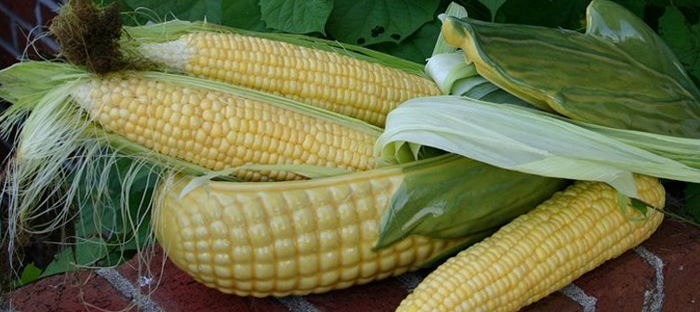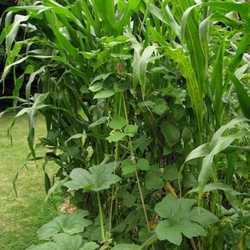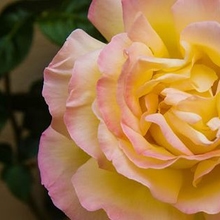Evidence shows that maize (corn) was domesticated and cultivated in central Mexico, in what is now the Tehuacan Valley. Scientists theorize that it is the product of crossing two types of grain or grasses. One ancestor, teosinte is a grass-like plant that resembles a type of wheat. The kernels are spaced along the stems much like wheat and the grains have a sheath, or hull, like so many grass varieties do. Between 7,000 and 9,000 years ago, people started selecting plants that displayed desirable characteristics and whether it was an accident or by plan, the plant was crossed with another primitive grass plant and the results were the first plants that vaguely resembled modern corn. The image at right shows the teosinte, the second-generation maize in the middle with modern corn at the bottom.
 Knowledge (and more importantly, seeds) of this new grain spread quickly through North and South America and by the time Columbus arrived in 1492, maize was a staple food crop of most of the native peoples in this hemisphere. Indigenous peoples depended on the dried harvest for much needed winter stores, but they also wove useful items such as baskets, mats and moccasins from the husks. A wealth of legends and lore concerning corn developed. Almost universally, the stories indicate that the gods came to earth and gave corn to the people as a gift. A number of harvest and fertility ceremonies were directly related to how corn influenced their daily lives.
Knowledge (and more importantly, seeds) of this new grain spread quickly through North and South America and by the time Columbus arrived in 1492, maize was a staple food crop of most of the native peoples in this hemisphere. Indigenous peoples depended on the dried harvest for much needed winter stores, but they also wove useful items such as baskets, mats and moccasins from the husks. A wealth of legends and lore concerning corn developed. Almost universally, the stories indicate that the gods came to earth and gave corn to the people as a gift. A number of harvest and fertility ceremonies were directly related to how corn influenced their daily lives.
When settlers finally reached the eastern seaboard of North America, they found the native population actively growing corn and were instructed on how to grow this life-saving crop for themselves. The word 'corn' is a European name and simply describes the local grain crop. Wheat, rye, oats and barley are all referred to as corn, depending on what part of the world you are in. The native peoples of New England had discovered by planting only the seeds from the first ears to form, they could breed varieties that took less time to mature and passed this information along to the settlers. The practice of planting beans and squash among the corn hills was also something that the Europeans learned. The corn stalks gave the bean vines support and the squash plants shaded the ground, conserving moisture and preventing weeds. Deer tend to avoid plants with fuzzy leaves and chances are, the squash plants were also a natural barrier to discourage them as well. This combination was known as the Three Sisters.
When corn was introduced to Europeans, it was considered mostly a garden curiosity (like many new world fruits and vegetables) but quickly established itself as an important food crop in France, Spain and Italy. By 1575, it had been introduced into China and Indonesia, stopping in North Africa along the way. The world embraced corn as a staple food and never looked back. Today, the U.S. Still grows the vast majority of the world's corn. China is #2 and Brazil #3, but their combined production still does not match that of the U.S. It would take adding the entirety of #4 producer to this group, the European Union, to match the production that the breadbasket of the U.S. churns out.
 Corn is planted in the spring after the ground warms. It germinates best when the soil is above 55 degrees (F) and tends to rot if the temperatures stay damp and cool. Depending on the variety and at what maturity you wish to harvest it, corn can be ready in as little as 60 days for some sweet corns that are eaten fresh. For full dry, mature ears, most varieties take about 120 days. Corn grows best in full sun and in a nitrogen-rich environment. Many home gardeners rotate their corn and beans to take advantage of the nitrogen the beans fix in the soil each year. It is ready for fresh eating between 15 and 20 days from the time the silks first emerge. This stage maximizes the sugars that quickly turn to starch as the ear of corn matures.
Corn is planted in the spring after the ground warms. It germinates best when the soil is above 55 degrees (F) and tends to rot if the temperatures stay damp and cool. Depending on the variety and at what maturity you wish to harvest it, corn can be ready in as little as 60 days for some sweet corns that are eaten fresh. For full dry, mature ears, most varieties take about 120 days. Corn grows best in full sun and in a nitrogen-rich environment. Many home gardeners rotate their corn and beans to take advantage of the nitrogen the beans fix in the soil each year. It is ready for fresh eating between 15 and 20 days from the time the silks first emerge. This stage maximizes the sugars that quickly turn to starch as the ear of corn matures.
Corn has a very important place in our history and even though it has some bad press lately with all the talk about GMOs and high fructose corn syrup, those are man-made items. We still owe a huge debt to whoever decided to grind those first kernels and cook that first tortilla on a flat rock by the fire thousands of years ago.
The teosinte image courtesy of Wikimedia commons and John Doebley, photographer, the other images belong to me.


















